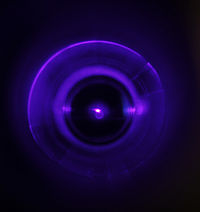LaserCooling
Contents
[hide]People
Post Docs
- Boerge Hemmerling
Grad Students
- Garrett Drayna
- Eunmi Chae
- Aakash Ravi
Collaborators(JILA)
- Jun Ye (PI), Matthew Hummon, Mark Yeo, Benjamin Stuhl, Alejandra Collopy, Yong Xia
Ye Group Ultracold Molecules Website
Overview
This experiment is investigating laser cooling and trapping methods as a route towards ultracold molecules. We first cool our species of interest to ~1K using buffer-gas cooling. After buffer-gas cooling, our species is extracted into a very slow beam, where laser cooling can proceed and stationary, 3D traps can be loaded. We are working to demonstrate the compatibility of buffer-gas cooling and laser cooling using atomic species, and we are working to demonstrate novel laser cooling methods in molecules.
Two-stage cryogenic buffer-gas cooled beams are an excellent precursors to laser cooling experiments as the thermal velocities of the atoms or molecules being cooled are comparable to the depth of traps (e.g., magneto-optical traps) [1-2]. In molecular systems, the buffer-gas cooled beams are relevant as well because they quench internal degrees of freedom (e.g., rotational) and thus create a large number of molecules in the ground state.
Laser Cooling and Trapping of Diatomic Radicals (CaF)
We are investigating magneto-optical trapping and cooling of diatomic molecules. Laser cooling of molecules requires buffer-gas cooling to produce samples of ground-state molecules which have necessary rotational phase space densities for current molecular laser cooling schemes. We use slow beam technology developed in our group [1] to reduce the amount of kinetic energy and number of cycled photons needed to bring molecules to rest in a 3D trap.
Currently, our group is working with the radical CaF. We have produced a slow, cryogenic beam of CaF with rotational cooling, and have demonstrated cycling of over 1000 photons (and up to 10^5) using the state-of-the-art laser cooling scheme demonstrated by Shuman et al. [3-4] Current work is ongoing to measure longitudinal slowing.
Laser Cooling of Atoms
We first investigated laser cooling and trapping of atoms from a buffer-gas beam. We made the first buffer-gas loaded MOT, using Yb atoms as our species of interest. This MOT, which used no slowing of any kind (Zeeman, laser, etc.), demonstrated the power of our very-slow beam technology, which we plan to use for a molecular MOT. Furthermore, this MOT demonstrated that, in principle, buffer-gas beam technology is compatible with 3D magneto-optical trapping.
References
- [1] Hsin-I Lu, Julia Rasmussen, Matthew J. Wright, Dave Patterson, and John M. Doyle. Phys. Chem. Chem. Phys., 2011, DOI: 10.1039/c1cp21206k.
- [2] D. Patterson and J.M. Doyle. J of Chem Phys 126, 154307 (2007).
- [3] E. S. Shuman, J. F. Barry, D. R. Glenn, and D. DeMille, Phys. Rev. Lett. 103, 223001 (2009).
- [4] E. S. Shuman, J. F. Barry, and D. DeMille. Nature 467, 820 (2010).
- [5] M. T. Hummon, M. Yeo, B. K. Stuhl, A. L. Collopy, Y. Xia, and J. Ye, “2D Magneto-Optical Trapping of Diatomic Molecules”, Physical Review Letters, vol. 110, no. 14, pp. 143001/1-5, 2013.

